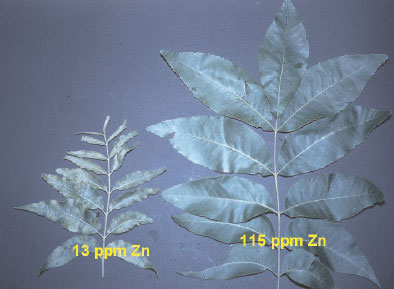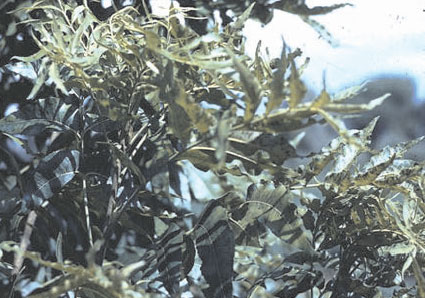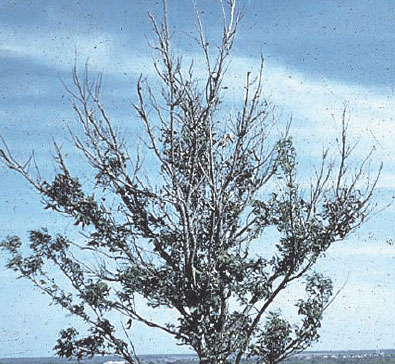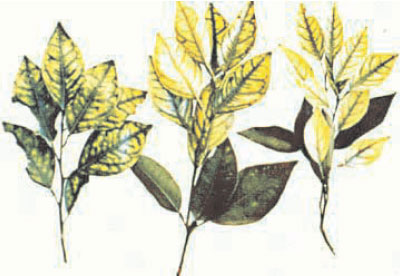Zinc Deficiency
Zinc deficiency is common in plants growing in highly weathered acid or calcareous soils
(16).
Roots of zinc-deficient trees often exude a gummy material. Major zinc-deficient sites are old barnyards
or corral sites, where an extra heavy manure application accumulated over the years. Zinc
ions become tied to organic matter to the extent that zinc is not available to the roots of peach trees
(17,18). Zinc deficiency initially appears in all plants as intervenial chlorosis (mottling) in which
lighter green to pale yellow color appears between the midrib and secondary veins (Figure 15.1 and
Figure 15.2) Developing leaves are smaller than normal, and the internodes are short. Popular
names describe these conditions as ‘little leaf’ and ‘rosette’
(19,20). Pecan trees in particular suffer
from shortened internodes (rosette) (Figure 15.3).
Shoot apices die (shoot die-back) under severe
zinc deficiency, as in a tree in Comanche county, Texas (Figure 15.4). Forest plantations in Australia
have shown similar symptoms
(21).
Citrus often show diffusive symptoms (mottle leaf) (Figure 15.5).
The ideal time to demonstrate citrus trace element deficiency symptoms is in winter months when the
soil is relatively cold. Treatment with zinc fertilizers is not necessary if the symptoms disappear when
the soil temperature rises in the spring. Sorghum (Sorghum bicolor Moench) that is deficient in zinc
forms chlorotic bands along the midrib and red spots on the leaves
(22). Shoots are more inhibited
by zinc deficiency than roots
(23). For most plants, the critical leaf zinc deficiency levels range from
10 to 100 mg kg
-1 depending on species (Table 15.1).
TABLE 15.1
Tissue Analysis Values Useful in Indicating Zinc Status
Click to view Table (Approx. 530KB) - opens a new window
Click to download a more clear image Table (Approx. 1.32MB)
 |
| FIGURE 15.1 Zinc deficiency of peaches (Prunus persica Batsch) is expressed as developing leaves that are
smaller than normal and the internodes are shorter causing leaves to be closer to each other and thence the popular
names which describes the terminal branches as 'little leaf'. |
 |
| FIGURE 15.2 Zinc-deficient pecan (Carya illinoinensis K. Koch) leaves (left) can contain less than 30mg
Zn per kg compared to over 80 mg Zn per kg Zn in healthy leaves (right). The zinc-deficient leaves have small
crinkled leaves that are mottled with yellow. Healthy zinc-sufficient leaves are dark green. Actual zinc concentration
of each leaf is shown in the photograph. |
 |
| FIGURE 15.3 Zinc-deficient pecan (Carya illinoinensis K. Koch) trees have shorter internodes so that the
leaves are closer together forming a rosette of poorly formed crinkled, chlorotic leaves. |
 |
| FIGURE 15.4 If the rosetted pecan (Carya illinoinensis K. Koch) trees are not treated, the terminals die followed
by death of the entire tree. Dieback can occur on young or old trees. |
 |
| FIGURE 15.5 Mottled leaf symptoms characterize zinc deficiency symptoms in citrus (Citrus spp. L.). |









